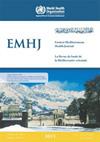巴勒斯坦被占领土约旦河西岸的蝎子蜇伤流行病学
IF 1.9
4区 医学
Q3 HEALTH CARE SCIENCES & SERVICES
引用次数: 0
摘要
背景:蝎子中毒(蝎子蜇伤)是许多中东阿拉伯国家普遍存在的公共卫生问题。然而,我们对约旦河西岸蝎子蜇伤流行病学的了解十分有限。目的:调查特定时期内约旦河西岸 4 个地区的蝎子蜇伤流行病学。方法:我们从约旦河西岸 4 个区的主要医院获得了 2012 年和 2014-2020 年的蝎子蜇伤记录。使用 SPSS 17 版对 2175 个病例进行了回顾性分析。结果:男性和女性的平均年龄和标准差(±SD)分别为 24.7±17.5 岁(22.7±16.5 岁和 27.1±18.4)。年龄中位数为20岁,47.2%为18岁以下儿童。大多数病例发生在夏季,即 6 月至 10 月,高峰期在 7 月至 8 月。从解剖部位来看,男女患者最常被蛰的部位都是右手,其次是右脚。胸部、臀部和阴囊是受影响最小的身体部位。有 405 个病例的临床数据,其中疼痛、呕吐和出汗是最常见的症状。在 8 年的研究期间,每 10 万名居民每年被蜇伤的总发病率为 26.32(59.21-171.67,95% CI)。结论蝎子蜇伤是约旦河西岸成人和儿童经常遇到的情况。有必要提高约旦河西岸居民对如何避免被蝎子蛰伤的认识,培训医务人员更好地处理蛰伤病例,并对医生目前用于治疗蝎子蛰伤的抗蛇毒血清进行评估。本文章由计算机程序翻译,如有差异,请以英文原文为准。
Epidemiology of scorpion stings in the West Bank, occupied Palestinian territory
Background: Scorpionism (scorpion sting envenoming) is an endemic public health concern in many Arab Middle Eastern countries. However, our knowledge of the epidemiology of scorpion stings in the West Bank is limited. Aim: To investigate the epidemiology of scorpion stings in 4 districts of the West Bank over a specified period. Methods: We obtained scorpion sting records from the main hospitals in 4 districts of the West Bank for 2012 and 20142020. A total of 2175 cases were analyzed retrospectively using SPSS version 17. Results: The average age and standard deviation (±SD) for both sexes was 24.7±17.5 years (22.7±16.5 and 27.1±18.4 years for males and females, respectively). The median age was 20 years and 47.2% were children under 18 years. Most cases were reported during the summer months, between June and October, with a peak in July–August. By anatomic site, the right hand was the most commonly stung in both sexes, followed by the right foot. The chest, buttocks and scrotum were the least affected body parts. Clinical data were available for 405 cases, in which pain, vomiting and sweating were the most common symptoms. The overall incidence of stings was 26.32 per 100 000 inhabitants per year over the study period of 8 years (59.21–171.67, 95% CI). Conclusion: Scorpion stings are commonly encountered by adults and children in the West Bank. There is a need for awareness among the West Bank populations on how to avoid being stung, to train medical staff to better manage sting cases, and to evaluate the antivenom currently being used by physicians for scorpion stings.
求助全文
通过发布文献求助,成功后即可免费获取论文全文。
去求助
来源期刊

Eastern Mediterranean Health Journal
HEALTH CARE SCIENCES & SERVICESPUBLIC, ENV-PUBLIC, ENVIRONMENTAL & OCCUPATIONAL HEALTH
CiteScore
3.30
自引率
4.80%
发文量
112
期刊介绍:
The Eastern Mediterranean Health Journal, established in 1995, is the flagship health periodical of the World Health Organization Regional Office for the Eastern Mediterranean.
The mission of the Journal is to contribute to improving health in the Eastern Mediterranean Region by publishing and publicising quality health research and information with emphasis on public health and the strategic health priorities of the Region. It aims to: further public health knowledge, policy, practice and education; support health policy-makers, researchers and practitioners; and enable health professionals to remain informed of developments in public health.
The EMHJ:
-publishes original peer-reviewed research and reviews in all areas of public health of relevance to the Eastern Mediterranean Region
-encourages, in particular, research related to the regional health priorities, namely: health systems strengthening; emergency preparedness and response; communicable diseases; noncommunicable diseases and mental health; reproductive, maternal, child health and nutrition
-provides up-to-date information on public health developments with special reference to the Region.
The Journal addresses all members of the health profession, health educational institutes, as well as governmental and nongovernmental organizations in the area of public health within and outside the Region.
 求助内容:
求助内容: 应助结果提醒方式:
应助结果提醒方式:


